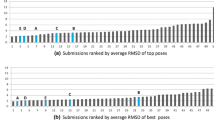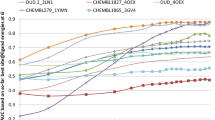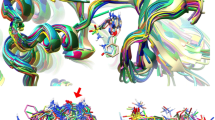Abstract
We report the performance of our newly introduced Ensemble Docking with Enhanced sampling of pocket Shape (EDES) protocol coupled to a template-based algorithm to generate near-native ligand conformations in the 2019 iteration of the Grand Challenge (GC4) organized by the D3R consortium. Using either AutoDock4.2 or HADDOCK2.2 docking programs (each software in two variants of the protocol) our method generated native-like poses among the top 5 submitted for evaluation for most of the 20 targets with similar performances. The protein selected for GC4 was the human beta-site amyloid precursor protein cleaving enzyme 1 (BACE-1), a transmembrane aspartic-acid protease. We identified at least one pose whose heavy-atoms RMSD was less than 2.5 Å from the native conformation for 16 (80%) and 17 (85%) of the 20 targets using AutoDock and HADDOCK, respectively. Dissecting the possible sources of errors revealed that: (i) our EDES protocol (with minor modifications) was able to sample sub-ångstrom conformations for all 20 protein targets, reproducing the correct conformation of the binding site within ~ 1 Å RMSD; (ii) as already shown by some of us in GC3, even in the presence of near-native protein structures, a proper selection of ligand conformers is crucial for the success of ensemble-docking calculations. Importantly, our approach performed best among the protocols exploiting only structural information of the apo protein to generate conformations of the receptor for ensemble-docking calculations.




Similar content being viewed by others
References
Gaieb Z, Parks CD, Chiu M et al (2019) D3R Grand Challenge 3: blind prediction of protein–ligand poses and affinity rankings. J Comput Aided Mol Des 33:1–18. https://doi.org/10.1007/s10822-018-0180-4
Gaieb Z, Liu S, Gathiaka S et al (2018) D3R Grand Challenge 2: blind prediction of protein–ligand poses, affinity rankings, and relative binding free energies. J Comput Aided Mol Des 32:1–20. https://doi.org/10.1007/s10822-017-0088-4
Gathiaka S, Liu S, Chiu M et al (2016) D3R grand challenge 2015: evaluation of protein–ligand pose and affinity predictions. J Comput Aided Mol Des 30:651–668. https://doi.org/10.1007/s10822-016-9946-8
Venugopal C, Demos C, Jagannatha Rao K et al (2008) Beta-secretase: structure, function, and evolution. CNS Neurol Disord 7:278–294. https://doi.org/10.2174/187152708784936626
Cole SL, Vassar R (2007) The Alzheimer’s disease beta-secretase enzyme, BACE1. Mol Neurodegener 2:22. https://doi.org/10.1186/1750-1326-2-22
Nalivaeva NN, Turner AJ (2013) The amyloid precursor protein: a biochemical enigma in brain development, function and disease. FEBS Lett 587:2046–2054. https://doi.org/10.1016/j.febslet.2013.05.010
Murphy MP, LeVine H (2010) Alzheimer’s disease and the amyloid-β peptide. J Alzheimers Dis 19:311–323. https://doi.org/10.3233/JAD-2010-1221
Berman HM, Westbrook J, Feng Z et al (2000) The Protein Data Bank. Nucleic Acids Res 28:235–242. https://doi.org/10.1093/nar/28.1.235
Prati F, Bottegoni G, Bolognesi ML, Cavalli A (2018) BACE-1 inhibitors: from recent single-target molecules to multitarget compounds for Alzheimer’s disease: miniperspective. J Med Chem 61:619–637. https://doi.org/10.1021/acs.jmedchem.7b00393
Moussa CE-H (2017) Beta-secretase inhibitors in phase I and phase II clinical trials for Alzheimer’s disease. Expert Opin Investig Drugs 26:1131–1136. https://doi.org/10.1080/13543784.2017.1369527
Amaro RE, Baudry J, Chodera J et al (2018) Ensemble docking in drug discovery. Biophys J 114:2271–2278. https://doi.org/10.1016/j.bpj.2018.02.038
Huang S-Y, Zou X (2007) Ensemble docking of multiple protein structures: considering protein structural variations in molecular docking. Proteins Struct Funct Bioinform 66:399–421. https://doi.org/10.1002/prot.21214
Basciu A, Malloci G, Pietrucci F et al (2019) Holo-like and druggable protein conformations from enhanced sampling of binding pocket volume and shape. J Chem Inf Model 59:1515–1528. https://doi.org/10.1021/acs.jcim.8b00730
Zhao H, Caflisch A (2015) Molecular dynamics in drug design. Eur J Med Chem 91:4–14. https://doi.org/10.1016/j.ejmech.2014.08.004
De Vivo M, Masetti M, Bottegoni G, Cavalli A (2016) Role of molecular dynamics and related methods in drug discovery. J Med Chem 59:4035–4061. https://doi.org/10.1021/acs.jmedchem.5b01684
Koukos PI, Xue LC, Bonvin AMJJ (2019) Protein–ligand pose and affinity prediction: lessons from D3R Grand Challenge 3. J Comput Aided Mol Des 33:83–91. https://doi.org/10.1007/s10822-018-0148-4
Hong L, Tang J (2004) Flap position of free memapsin 2 (β-secretase), a model for flap opening in aspartic protease catalysis. Biochemistry 43:4689–4695. https://doi.org/10.1021/bi0498252
Laio A, Parrinello M (2002) Escaping free-energy minima. Proc Natl Acad Sci USA 99:12562–12566. https://doi.org/10.1073/pnas.202427399
Hawkins PCD, Skillman AG, Warren GL et al (2010) Conformer generation with OMEGA: algorithm and validation using high quality structures from the protein databank and cambridge structural database. J Chem Inf Model 50:572–584. https://doi.org/10.1021/ci100031x
Morris GM, Huey R, Lindstrom W et al (2009) AutoDock4 and AutoDockTools4: automated docking with selective receptor flexibility. J Comput Chem 30:2785–2791.
Dominguez C, Boelens R, Bonvin AMJJ (2003) HADDOCK: a protein−protein docking approach based on biochemical or biophysical information. J Am Chem Soc 125:1731–1737. https://doi.org/10.1021/ja026939x
van Zundert GCP, Rodrigues JPGLM, Trellet M et al (2016) The HADDOCK2.2 web server: user-friendly integrative modeling of biomolecular complexes. Comput Resour Mol Biol 428:720–725. https://doi.org/10.1016/j.jmb.2015.09.014
Hawkins PCD, Skillman AG, Nicholls A (2007) Comparison of shape-matching and docking as virtual screening tools. J Med Chem 50:74–82. https://doi.org/10.1021/jm0603365
Wang Y, Backman TWH, Horan K, Girke T (2013) fmcsR: mismatch tolerant maximum common substructure searching in R. Bioinformatics 29:2792–2794. https://doi.org/10.1093/bioinformatics/btt475
Cao Y, Charisi A, Cheng L-C et al (2008) ChemmineR: a compound mining framework for R. Bioinformatics 24:1733–1734. https://doi.org/10.1093/bioinformatics/btn307
Kurkcuoglu Z, Koukos PI, Citro N et al (2018) Performance of HADDOCK and a simple contact-based protein–ligand binding affinity predictor in the D3R Grand Challenge 2. J Comput Aided Mol Des 32:175–185. https://doi.org/10.1007/s10822-017-0049-y
Altschul SF, Gish W, Miller W et al (1990) Basic local alignment search tool. J Mol Biol 215:403–410. https://doi.org/10.1016/S0022-2836(05)80360-2
Williams CJ, Headd JJ, Moriarty NW et al (2018) MolProbity: more and better reference data for improved all-atom structure validation: PROTEIN SCIENCE.ORG. Protein Sci 27:293–315. https://doi.org/10.1002/pro.3330
Case DA, Ben-Shalom IY, Brozell SR et al (2018) AMBER18. University of California, San Francisco
Wang L-P, Martinez TJ, Pande VS (2014) Building force fields: an automatic, systematic, and reproducible approach. J Phys Chem Lett 5:1885–1891. https://doi.org/10.1021/jz500737m
Wang L-P, McKiernan KA, Gomes J et al (2017) Building a more predictive protein force field: a systematic and reproducible route to AMBER-FB15. J Phys Chem B 121:4023–4039. https://doi.org/10.1021/acs.jpcb.7b02320
Joung IS, Cheatham TE (2008) Determination of alkali and halide monovalent ion parameters for use in explicitly solvated biomolecular simulations. J Phys Chem B 112:9020–9041. https://doi.org/10.1021/jp8001614
Hopkins CW, Le Grand S, Walker RC, Roitberg AE (2015) Long-time-step molecular dynamics through hydrogen mass repartitioning. J Chem Theory Comput 11:1864–1874. https://doi.org/10.1021/ct5010406
Barducci A, Bussi G, Parrinello M (2008) Well-tempered metadynamics: a smoothly converging and tunable free-energy method. Phys Rev Lett 100:020603. https://doi.org/10.1103/PhysRevLett.100.020603
Piana S, Laio A (2007) A bias-exchange approach to protein folding. J Phys Chem B 111:4553–4559. https://doi.org/10.1021/jp067873l
Abraham MJ, Murtola T, Schulz R et al (2015) GROMACS: high performance molecular simulations through multi-level parallelism from laptops to supercomputers. SoftwareX. https://doi.org/10.1016/j.softx.2015.06.001
Tribello GA, Bonomi M, Branduardi D et al (2014) PLUMED 2: new feathers for an old bird. Comput Phys Commun 185:604–613. https://doi.org/10.1016/j.cpc.2013.09.018
Sousa da Silva AW, Vranken WF (2012) ACPYPE - AnteChamber PYthon Parser interfacE. BMC Res Notes 5:367. https://doi.org/10.1186/1756-0500-5-367
Hayward S (2004) Identification of specific interactions that drive ligand-induced closure in five enzymes with classic domain movements. J Mol Biol 339:1001–1021. https://doi.org/10.1016/j.jmb.2004.04.004
Gerstein M (1998) A database of macromolecular motions. Nucleic Acids Res 26:4280–4290. https://doi.org/10.1093/nar/26.18.4280
van Aalten DMF, Bywater R, Findlay JBC et al (1996) PRODRG, a program for generating molecular topologies and unique molecular descriptors from coordinates of small molecules. J Comput Aided Mol Des 10:255–262. https://doi.org/10.1007/BF00355047
Wang J, Wolf RM, Caldwell JW et al (2004) Development and testing of a general amber force field. J Comput Chem 25:1157–1174
Le Guilloux V, Schmidtke P, Tuffery P (2009) Fpocket: an open source platform for ligand pocket detection. BMC Bioinform 10:168. https://doi.org/10.1186/1471-2105-10-168
Schmidtke P, Barril X (2010) Understanding and predicting druggability. A High-throughput method for detection of drug binding sites. J Med Chem 53:5858–5867. https://doi.org/10.1021/jm100574m
Antunes DA, Devaurs D, Kavraki LE (2015) Understanding the challenges of protein flexibility in drug design. Expert Opin Drug Discov 10:1301–1313. https://doi.org/10.1517/17460441.2015.1094458
Du X, Li Y, Xia Y-L et al (2016) Insights into protein–ligand interactions: mechanisms, models, and methods. Int J Mol Sci 17:144. https://doi.org/10.3390/ijms17020144
Buonfiglio R, Recanatini M, Masetti M (2015) Protein flexibility in drug discovery: from theory to computation. ChemMedChem 10:1141–1148. https://doi.org/10.1002/cmdc.201500086
Chen I-J, Foloppe N (2013) Tackling the conformational sampling of larger flexible compounds and macrocycles in pharmacology and drug discovery. Bioorg Med Chem 21:7898–7920. https://doi.org/10.1016/j.bmc.2013.10.003
Cleves AE, Jain AN (2017) ForceGen 3D structure and conformer generation: from small lead-like molecules to macrocyclic drugs. J Comput Aided Mol Des 31:419–439. https://doi.org/10.1007/s10822-017-0015-8
Jain AN, Cleves AE, Gao Q et al (2019) Complex macrocycle exploration: parallel, heuristic, and constraint-based conformer generation using ForceGen. J Comput Aided Mol Des 33:531–558. https://doi.org/10.1007/s10822-019-00203-1
Tarcsay Á, Paragi G, Vass M et al (2013) The impact of molecular dynamics sampling on the performance of virtual screening against GPCRs. J Chem Inf Model 53:2990–2999. https://doi.org/10.1021/ci400087b
Li YY, An J, Jones SJ (2011) A computational approach to finding novel targets for existing drugs. PLoS Comput Biol 7:e1002139
Amaro RE, Li WW (2010) Emerging methods for ensemble-based virtual screening. Curr Top Med Chem 10:3–13
Acknowledgements
A.B. gratefully acknowledges the Sardinia Regional Government for the financial support of his Ph.D. scholarship (P.O.R. Sardegna F.SE., Operational Programme of the Autonomous Region of Sardinia, European Social Fund 2014–2020—Axis III Education and Training, Thematic Goal 10, Priority of Investment 10ii, Specific Goal 10.5., Action Partnership Agreement 10.5.12). This work was done as part of the BioExcel CoE (www.bioexcel.eu), a project funded by the European Union Horizon 2020 Program under Grant Agreements 675728 and 823830 (to A. M. J. J. B.) with financial support from the Dutch Foundation for Scientific Research (NWO) (TOP-PUNT Grant 718.015.001.
Author information
Authors and Affiliations
Corresponding authors
Additional information
Publisher's Note
Springer Nature remains neutral with regard to jurisdictional claims in published maps and institutional affiliations.
Electronic supplementary material
Below is the link to the electronic supplementary material.
Rights and permissions
About this article
Cite this article
Basciu, A., Koukos, P.I., Malloci, G. et al. Coupling enhanced sampling of the apo-receptor with template-based ligand conformers selection: performance in pose prediction in the D3R Grand Challenge 4. J Comput Aided Mol Des 34, 149–162 (2020). https://doi.org/10.1007/s10822-019-00244-6
Received:
Accepted:
Published:
Issue Date:
DOI: https://doi.org/10.1007/s10822-019-00244-6




